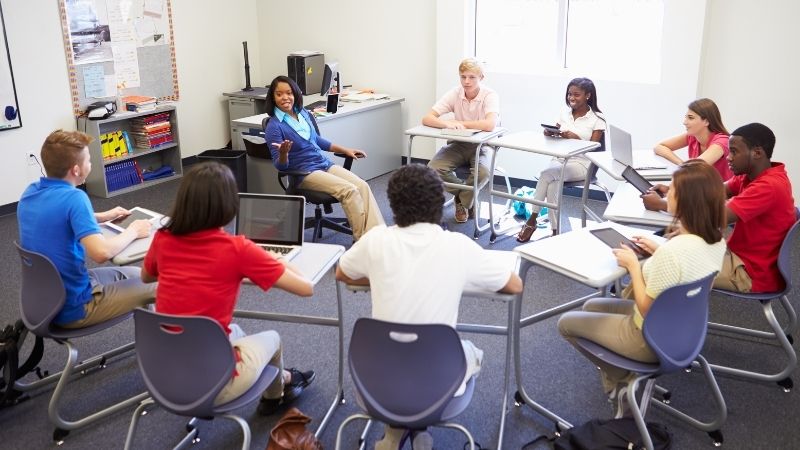
In the realm of education, schools serve as guardians, ensuring the safety and well-being of their students. This article delves into the comprehensive implementation of school safety measures, with a focus on emergency drills, bullying prevention programs, school security measures, initiatives for student well-being, and safety protocols.
By examining the formulation and execution of these strategies, this article aims to create a safe learning atmosphere for all students. Key considerations for successful implementation will also be explored to provide readers with proactive insights that foster freedom within educational spaces.
Key Takeaways
- Familiarize students and staff with proper emergency procedures
- Implement comprehensive bullying prevention programs addressing root causes
- Prioritize student well-being through mental health support and social-emotional development
- Enhance school security measures through physical infrastructure assessment and collaboration with law enforcement agencies
The Importance of Emergency Drills
The significance of conducting regular emergency drills lies in their ability to familiarize students and staff with proper procedures, enhance preparedness, and mitigate potential risks during unforeseen incidents.
By practicing emergency drill procedures, students and staff become familiar with the necessary actions to take in various emergency situations, such as fires, natural disasters, or intruders. This familiarity increases their ability to respond effectively and efficiently when faced with an actual emergency.
Furthermore, regular emergency drills serve as proactive measures to ensure that everyone is adequately prepared for any potential risks that may arise. These drills also provide an opportunity to identify areas for improvement in existing protocols or evacuation routes. As such, frequent emergency drill frequency is crucial in maintaining a state of readiness within educational institutions.
Transitioning into the subsequent section about strategies for implementing bullying prevention programs...
Strategies for Implementing Bullying Prevention Programs
This discussion will focus on strategies for implementing bullying prevention programs, with a specific emphasis on effective program components, student involvement and engagement, and tracking and evaluating progress.

Effective program components refer to the elements that are necessary for a successful bullying prevention program, such as clear policies, staff training, and evidence-based interventions.
Student involvement and engagement are crucial in creating a positive school climate where students feel empowered to address bullying behaviors.
Effective Program Components
Effective program components for school safety measures include:
Well-designed emergency drills: These drills allow students to practice appropriate responses during various crisis situations, ensuring they are prepared and able to act quickly when necessary.
Comprehensive bullying prevention programs: These programs address the root causes of bullying behavior and provide support for both victims and perpetrators.
Efficient school security measures: These measures employ a range of strategies such as surveillance systems, controlled access points, and trained personnel to deter potential threats.
Student well-being initiatives: These initiatives prioritize the mental health and emotional development of students through counseling services and peer support programs.

Established safety protocols: These protocols outline clear procedures for handling emergencies or dangerous situations, providing consistency in response efforts.
These components play a crucial role in ensuring the safety and well-being of students within educational settings. They contribute to a safe learning environment that fosters student support and effective program evaluation.
Student Involvement and Engagement
Student involvement and engagement can significantly contribute to the overall effectiveness of school safety measures. When students actively participate in safety initiatives, they become partners in creating a secure learning environment. Encouraging student participation not only empowers them but also fosters a sense of ownership and responsibility towards their own safety and that of their peers.
Schools can engage students by involving them in the development and implementation of safety programs, such as emergency drills or bullying prevention initiatives. Additionally, community engagement plays a crucial role in ensuring comprehensive school safety. By involving parents, local organizations, law enforcement agencies, and other stakeholders, schools can create a collaborative approach to addressing potential risks and strengthening protective measures.
In this way, student participation and community engagement work together to enhance the efficacy of school safety efforts.
To track and evaluate progress in implementing school safety measures effectively...
Tracking and Evaluating Progress
To effectively track and evaluate progress in the implementation of school safety measures, an objective and systematic approach is necessary. This involves establishing clear benchmarks and indicators to assess the effectiveness of various initiatives aimed at ensuring a safe learning atmosphere for all students.

Tracking progress requires ongoing monitoring and data collection to measure the extent to which safety measures are being implemented as intended.
Evaluating effectiveness involves analyzing this data to determine whether the implemented measures are achieving their desired outcomes, such as reducing bullying incidents or improving emergency response times.
By adopting a proactive approach, schools can identify areas where improvements are needed and make informed decisions about adjustments or additional interventions.
Regular evaluation ensures that resources are allocated effectively and that the safety of students remains a top priority.
Enhancing School Security Measures
The implementation of enhanced school security measures involves the assessment and improvement of physical infrastructure, installation of surveillance systems, and establishment of access control protocols.
Security assessments are conducted to identify vulnerabilities and weaknesses in the current system. This proactive approach allows for the identification of potential risks and enables schools to develop risk management strategies accordingly.
Physical infrastructure improvements may include installing stronger doors, windows, and locks to prevent unauthorized access. The installation of surveillance systems provides real-time monitoring and recording capabilities to enhance situational awareness.

Access control protocols involve implementing measures such as ID card systems or biometric scanners to ensure that only authorized individuals can enter school premises.
Holistic Initiatives for Student Well-Being
Holistic initiatives for student well-being encompass a comprehensive approach to addressing the physical, mental, and emotional needs of students within an educational setting. These initiatives recognize that students' well-being goes beyond their academic achievements and includes their mental health support. Implementing such initiatives requires collaboration with community partners who can contribute resources and expertise in promoting student well-being.
Mental health support is crucial for ensuring the overall well-being of students. Schools can establish counseling services, provide access to trained professionals, and implement awareness programs to address mental health issues among students. Additionally, community partnerships with mental health organizations can offer specialized services and resources.
Collaborating with community partners also extends beyond mental health support. Organizations specializing in physical wellness or social-emotional development can contribute valuable resources and expertise to holistic initiatives for student well-being. By forming these partnerships, schools can enhance their ability to meet the diverse needs of their students and create a supportive environment conducive to learning and growth.
Establishing Safety Protocols for All Students
This discussion will focus on three key points related to establishing safety protocols for all students: the effectiveness of emergency drills, bullying prevention strategies, and student well-being initiatives.
The effectiveness of emergency drills is crucial in preparing students for unexpected situations and ensuring their safety.
Bullying prevention strategies play an important role in creating a positive school environment and protecting students from harm.

Finally, student well-being initiatives aim to address various aspects of students' physical, mental, and emotional health, promoting a supportive learning atmosphere.
Emergency Drill Effectiveness
One aspect of evaluating emergency drill effectiveness is examining the level of student and staff participation.
The frequency of emergency drills plays a crucial role in ensuring preparedness and response during crises. Regular practice allows students and staff to become familiar with emergency protocols, reducing panic and promoting efficient evacuation procedures.
Additionally, conducting realistic emergency drill simulations enhances the effectiveness of these exercises. Simulations that closely resemble real-life scenarios help participants develop the necessary skills and confidence needed to respond effectively in emergencies. By incorporating various hypothetical situations into drills, schools can better prepare individuals for different types of emergencies they may encounter.
Overall, frequent emergency drills coupled with realistic simulations contribute to effective preparedness, enhancing the safety and security measures within educational institutions.
Bullying Prevention Strategies
To effectively address bullying in educational institutions, it is crucial to develop comprehensive prevention strategies that encompass multiple dimensions of the school environment. In order to create a safe and supportive atmosphere for all students, schools can implement the following strategies:
Cyberbullying prevention: Schools should educate students on responsible digital citizenship and the potential consequences of online harassment. This can be achieved through workshops, presentations, and awareness campaigns.

Peer mediation programs: Encouraging peer support and conflict resolution skills can empower students to resolve conflicts in a nonviolent manner. Peer mediation programs provide a structured framework for students to mediate disputes between their peers.
Establishing clear policies and procedures: Schools must have clear guidelines in place regarding bullying behaviors, reporting mechanisms, and consequences for perpetrators. By consistently enforcing these policies, schools send a strong message that bullying will not be tolerated.
By implementing these proactive measures, educational institutions can create an environment that promotes positive relationships among students while effectively addressing instances of bullying.
Transitioning into student well-being initiatives is essential to further enhance the overall safety and welfare of all individuals within the school community.
Student Well-Being Initiatives
Student well-being initiatives aim to promote the overall health and happiness of students by addressing their physical, mental, and emotional needs within the educational setting. These initiatives recognize that student well-being is essential for academic success and personal growth.
Schools have implemented various support programs to address mental health concerns among students. Such programs include counseling services, peer support groups, and workshops on stress management and mindfulness.
Additionally, schools have focused on creating a positive school climate that fosters students' social-emotional development. This involves promoting inclusivity, empathy, and respect among students through anti-bullying campaigns and character education programs.

Creating a Safe Learning Atmosphere
Implementing comprehensive safety protocols is crucial for creating a safe learning atmosphere that fosters student well-being and minimizes potential threats. To achieve this, schools can focus on the following:
Mental health support: Prioritizing mental health resources and services within the school community helps identify and address any emotional or psychological challenges students may face, promoting their overall well-being.
Community involvement: Engaging parents, teachers, and community members in safety initiatives ensures a collective effort to maintain a secure learning environment. Collaboration between school staff and external stakeholders enhances vigilance, communication, and problem-solving capabilities.
Proactive safety measures: Implementing proactive security measures such as surveillance systems, controlled access to facilities, and regular safety drills equips students with knowledge of emergency procedures while deterring potential threats.
Key Considerations for School Safety Implementation
One important aspect to consider when implementing school safety measures is the involvement of community stakeholders in order to enhance overall vigilance and problem-solving capabilities.
Community stakeholders, such as parents, local law enforcement agencies, and community organizations, play a crucial role in ensuring the safety of schools. Their active participation can provide valuable insights into the specific needs and challenges faced by each school.
By collaborating with these stakeholders, schools can develop comprehensive safety plans that address potential implementation challenges and incorporate best practices. This proactive approach allows for a more holistic understanding of the safety measures needed to create a safe learning atmosphere for all students.

Moreover, involving community stakeholders fosters a sense of collective responsibility and ownership over school safety, leading to increased commitment and effectiveness in implementing these measures.
Frequently Asked Questions
How Often Should Emergency Drills Be Conducted in Schools?
Emergency drills in schools should be conducted regularly to ensure preparedness for potential emergencies. The frequency of these drills should be determined based on local regulations and the specific needs of the school community, with an emphasis on actively involving students in the process.
What Specific Strategies Can Be Used to Involve Students in the Implementation of Bullying Prevention Programs?
To involve students in the implementation of bullying prevention programs, specific strategies can be employed. These strategies may include promoting student engagement through activities that raise awareness about bullying and fostering peer support networks to address instances of bullying effectively.
Are There Any Specific Technologies or Systems That Can Be Implemented to Enhance School Security Measures?
Enhancing school safety measures can be achieved through the implementation of various school security technologies. These technologies include surveillance cameras, access control systems, and emergency notification systems, which contribute to creating a secure learning environment for all students.
How Can Schools Ensure That Holistic Initiatives for Student Well-Being Are Integrated Into the Overall Curriculum and School Environment?
Integration challenges arise when incorporating holistic initiatives for student well-being into the curriculum and school environment. Curriculum enhancement can be achieved by integrating mental health programs, social-emotional learning activities, and promoting a positive school climate through teacher training and community partnerships.
What Steps Should Be Taken to Involve Parents and the Wider Community in the Establishment of Safety Protocols for All Students?
Collaboration and communication are essential for involving parents and the wider community in establishing safety protocols for all students. By actively engaging them, schools can improve student well-being through support systems and address mental health concerns effectively.
 Careers in EducationElementary EducationHigh School EducationEducational TechnologyTeaching StrategiesSpecial EducationPrivacy PolicyTerms And Conditions
Careers in EducationElementary EducationHigh School EducationEducational TechnologyTeaching StrategiesSpecial EducationPrivacy PolicyTerms And Conditions
